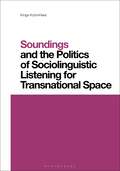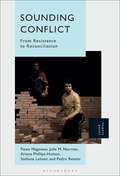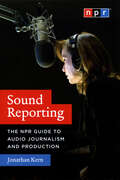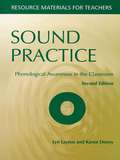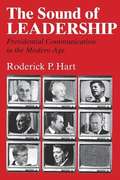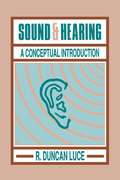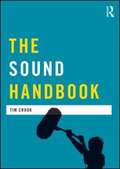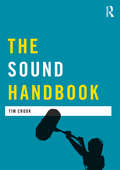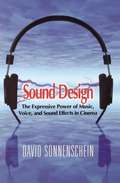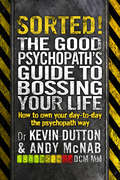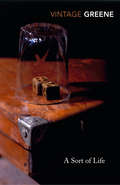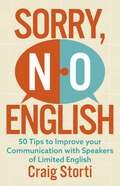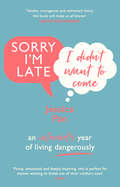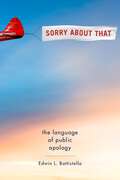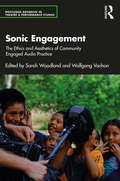- Table View
- List View
Soundings and the Politics of Sociolinguistic Listening for Transnational Space (Contemporary Studies in Linguistics)
by Kinga KozminskaIn a world dominated by the visual, this book presents how a focus on the sounded experience and acts of listening may carve a way to reformulate emerging publics, create space for critical multilingual engagement and deepen recognition of emancipatory practices. Examining the emerging logics and rhythms among a group of post-EU accession UK Polish migrants, this book focuses on the semiotic processes through which contemporary moving bodies and communities place themselves in sociolinguistic landscapes. It considers how they develop metrics to account for sociolinguistic change and authenticate their projects and practices in transnational timespace. In doing so, the book brings power differentials to the centre of language and objectivity debates and foregrounds material semiotics as an approach that enables a new collective potential and redefinition of sociolinguistic listening. By connecting research on scale in migration contexts with studies of embodied soundwork and of stance in semiotics, this book highlights how a focus on the sounded sign may bring us closer to the ways in which bodies and meanings are (re)made, and collective doing and thinking are formed in the globalised world.
Sounding Conflict: From Resistance to Reconciliation
by Fiona Magowan Pedro Rebelo Stefanie Lehner Julie M. Norman Ariana Phillips-HuttonSound, music and storytelling are important tools of resistance, resilience and reconciliation in creative practice from protracted conflict to post-conflict contexts. When they are used in a socially engaged participatory capacity, they can create counter-narratives to conflict. Based on original research in three continents, this book advances an interdisciplinary, comparative approach to exploring the role of sonic and creative practices in addressing the effects of conflict. Each case study illustrates how participatory arts genres are variously employed by musicians, arts facilitators, theatre practitioners, community activists and other stakeholders as a means of 'strategic creativity' to transform trauma and promote empowerment. This research further highlights the complex dynamics of delivering and managing creativity among those who have experienced violence, as they seek opportunities to generate alternative arenas for engagement, healing and transformation.
Sounding Conflict: From Resistance to Reconciliation
by Fiona Magowan Pedro Rebelo Stefanie Lehner Julie M. Norman Ariana Phillips-HuttonSound, music and storytelling are important tools of resistance, resilience and reconciliation in creative practice from protracted conflict to post-conflict contexts. When they are used in a socially engaged participatory capacity, they can create counter-narratives to conflict. Based on original research in three continents, this book advances an interdisciplinary, comparative approach to exploring the role of sonic and creative practices in addressing the effects of conflict. Each case study illustrates how participatory arts genres are variously employed by musicians, arts facilitators, theatre practitioners, community activists and other stakeholders as a means of 'strategic creativity' to transform trauma and promote empowerment. This research further highlights the complex dynamics of delivering and managing creativity among those who have experienced violence, as they seek opportunities to generate alternative arenas for engagement, healing and transformation.
Sound Reporting: The NPR Guide to Audio Journalism and Production
by Jonathan KernPerhaps you’ve always wondered how public radio gets that smooth, well-crafted sound. Maybe you’re thinking about starting a podcast, and want some tips from the pros. Or maybe storytelling has always been a passion of yours, and you want to learn to do it more effectively. Whatever the case—whether you’re an avid NPR listener or you aspire to create your own audio, or both—Sound Reporting: The NPR Guide to Audio Journalism and Production will give you a rare tour of the world of a professional broadcaster. Jonathan Kern, who has trained NPR’s on-air staff for years, is a gifted guide, able to narrate a day in the life of a host and lay out the nuts and bolts of production with equal wit and warmth. Along the way, he explains the importance of writing the way you speak, reveals how NPR books guests ranging from world leaders to neighborhood newsmakers, and gives sage advice on everything from proposing stories to editors to maintaining balance and objectivity. Best of all—because NPR wouldn’t be NPR without its array of distinctive voices—lively examples from popular shows and colorful anecdotes from favorite personalities animate each chapter. As public radio’s audience of millions can attest, NPR’s unique guiding principles and technical expertise combine to connect with listeners like no other medium can. With today’s technologies allowing more people to turn their home computers into broadcast studios, Sound Reporting couldn’t have arrived at a better moment to reveal the secrets behind the story of NPR’s success.
Sound Reporting: The NPR Guide to Audio Journalism and Production
by Jonathan KernPerhaps you’ve always wondered how public radio gets that smooth, well-crafted sound. Maybe you’re thinking about starting a podcast, and want some tips from the pros. Or maybe storytelling has always been a passion of yours, and you want to learn to do it more effectively. Whatever the case—whether you’re an avid NPR listener or you aspire to create your own audio, or both—Sound Reporting: The NPR Guide to Audio Journalism and Production will give you a rare tour of the world of a professional broadcaster. Jonathan Kern, who has trained NPR’s on-air staff for years, is a gifted guide, able to narrate a day in the life of a host and lay out the nuts and bolts of production with equal wit and warmth. Along the way, he explains the importance of writing the way you speak, reveals how NPR books guests ranging from world leaders to neighborhood newsmakers, and gives sage advice on everything from proposing stories to editors to maintaining balance and objectivity. Best of all—because NPR wouldn’t be NPR without its array of distinctive voices—lively examples from popular shows and colorful anecdotes from favorite personalities animate each chapter. As public radio’s audience of millions can attest, NPR’s unique guiding principles and technical expertise combine to connect with listeners like no other medium can. With today’s technologies allowing more people to turn their home computers into broadcast studios, Sound Reporting couldn’t have arrived at a better moment to reveal the secrets behind the story of NPR’s success.
Sound Reporting: The NPR Guide to Audio Journalism and Production
by Jonathan KernPerhaps you’ve always wondered how public radio gets that smooth, well-crafted sound. Maybe you’re thinking about starting a podcast, and want some tips from the pros. Or maybe storytelling has always been a passion of yours, and you want to learn to do it more effectively. Whatever the case—whether you’re an avid NPR listener or you aspire to create your own audio, or both—Sound Reporting: The NPR Guide to Audio Journalism and Production will give you a rare tour of the world of a professional broadcaster. Jonathan Kern, who has trained NPR’s on-air staff for years, is a gifted guide, able to narrate a day in the life of a host and lay out the nuts and bolts of production with equal wit and warmth. Along the way, he explains the importance of writing the way you speak, reveals how NPR books guests ranging from world leaders to neighborhood newsmakers, and gives sage advice on everything from proposing stories to editors to maintaining balance and objectivity. Best of all—because NPR wouldn’t be NPR without its array of distinctive voices—lively examples from popular shows and colorful anecdotes from favorite personalities animate each chapter. As public radio’s audience of millions can attest, NPR’s unique guiding principles and technical expertise combine to connect with listeners like no other medium can. With today’s technologies allowing more people to turn their home computers into broadcast studios, Sound Reporting couldn’t have arrived at a better moment to reveal the secrets behind the story of NPR’s success.
Sound Reporting: The NPR Guide to Audio Journalism and Production
by Jonathan KernPerhaps you’ve always wondered how public radio gets that smooth, well-crafted sound. Maybe you’re thinking about starting a podcast, and want some tips from the pros. Or maybe storytelling has always been a passion of yours, and you want to learn to do it more effectively. Whatever the case—whether you’re an avid NPR listener or you aspire to create your own audio, or both—Sound Reporting: The NPR Guide to Audio Journalism and Production will give you a rare tour of the world of a professional broadcaster. Jonathan Kern, who has trained NPR’s on-air staff for years, is a gifted guide, able to narrate a day in the life of a host and lay out the nuts and bolts of production with equal wit and warmth. Along the way, he explains the importance of writing the way you speak, reveals how NPR books guests ranging from world leaders to neighborhood newsmakers, and gives sage advice on everything from proposing stories to editors to maintaining balance and objectivity. Best of all—because NPR wouldn’t be NPR without its array of distinctive voices—lively examples from popular shows and colorful anecdotes from favorite personalities animate each chapter. As public radio’s audience of millions can attest, NPR’s unique guiding principles and technical expertise combine to connect with listeners like no other medium can. With today’s technologies allowing more people to turn their home computers into broadcast studios, Sound Reporting couldn’t have arrived at a better moment to reveal the secrets behind the story of NPR’s success.
Sound Reporting: The NPR Guide to Audio Journalism and Production
by Jonathan KernPerhaps you’ve always wondered how public radio gets that smooth, well-crafted sound. Maybe you’re thinking about starting a podcast, and want some tips from the pros. Or maybe storytelling has always been a passion of yours, and you want to learn to do it more effectively. Whatever the case—whether you’re an avid NPR listener or you aspire to create your own audio, or both—Sound Reporting: The NPR Guide to Audio Journalism and Production will give you a rare tour of the world of a professional broadcaster. Jonathan Kern, who has trained NPR’s on-air staff for years, is a gifted guide, able to narrate a day in the life of a host and lay out the nuts and bolts of production with equal wit and warmth. Along the way, he explains the importance of writing the way you speak, reveals how NPR books guests ranging from world leaders to neighborhood newsmakers, and gives sage advice on everything from proposing stories to editors to maintaining balance and objectivity. Best of all—because NPR wouldn’t be NPR without its array of distinctive voices—lively examples from popular shows and colorful anecdotes from favorite personalities animate each chapter. As public radio’s audience of millions can attest, NPR’s unique guiding principles and technical expertise combine to connect with listeners like no other medium can. With today’s technologies allowing more people to turn their home computers into broadcast studios, Sound Reporting couldn’t have arrived at a better moment to reveal the secrets behind the story of NPR’s success.
Sound Reporting: The NPR Guide to Audio Journalism and Production
by Jonathan KernPerhaps you’ve always wondered how public radio gets that smooth, well-crafted sound. Maybe you’re thinking about starting a podcast, and want some tips from the pros. Or maybe storytelling has always been a passion of yours, and you want to learn to do it more effectively. Whatever the case—whether you’re an avid NPR listener or you aspire to create your own audio, or both—Sound Reporting: The NPR Guide to Audio Journalism and Production will give you a rare tour of the world of a professional broadcaster. Jonathan Kern, who has trained NPR’s on-air staff for years, is a gifted guide, able to narrate a day in the life of a host and lay out the nuts and bolts of production with equal wit and warmth. Along the way, he explains the importance of writing the way you speak, reveals how NPR books guests ranging from world leaders to neighborhood newsmakers, and gives sage advice on everything from proposing stories to editors to maintaining balance and objectivity. Best of all—because NPR wouldn’t be NPR without its array of distinctive voices—lively examples from popular shows and colorful anecdotes from favorite personalities animate each chapter. As public radio’s audience of millions can attest, NPR’s unique guiding principles and technical expertise combine to connect with listeners like no other medium can. With today’s technologies allowing more people to turn their home computers into broadcast studios, Sound Reporting couldn’t have arrived at a better moment to reveal the secrets behind the story of NPR’s success.
Sound Practice: Phonological Awareness in the Classroom
by Lyn Layton Karen DeenyThe second edition of Sound Practice looks afresh at how young children can be helped to discover basic facts about an alphabetic spelling system, within the context of their developing spoken language. It examines why children might fail to understand letter-sound links; the origins of severe and persistent difficulties with achieving functional literacy skills; and developmental processes underpinning the areas of learning identified in national initiatives for promoting children's learning. The book also discusses the need for differentiation strategies to respond to individual children's learning needs within national initiatives, and techniques and approaches that can be effectively applied to fulfil curriculum objectives. Phonological awareness is the key to independent literacy and must be explicitly tackled in the classroom in order to promote early reading and writing and to address written language difficulties in older children. This book is a suitable resource for initial and in-service training for teachers and teaching assistants and includes photocopiable worksheets.
Sound Practice: Phonological Awareness in the Classroom (Resource Materials For Teachers Ser.)
by Lyn Layton Karen DeenyThe second edition of Sound Practice looks afresh at how young children can be helped to discover basic facts about an alphabetic spelling system, within the context of their developing spoken language. It examines why children might fail to understand letter-sound links; the origins of severe and persistent difficulties with achieving functional literacy skills; and developmental processes underpinning the areas of learning identified in national initiatives for promoting children's learning. The book also discusses the need for differentiation strategies to respond to individual children's learning needs within national initiatives, and techniques and approaches that can be effectively applied to fulfil curriculum objectives. Phonological awareness is the key to independent literacy and must be explicitly tackled in the classroom in order to promote early reading and writing and to address written language difficulties in older children. This book is a suitable resource for initial and in-service training for teachers and teaching assistants and includes photocopiable worksheets.
The Sound of Leadership: Presidential Communication in the Modern Age
by Roderick P. HartWhy did Gerald Ford speak in public once every six hours during 1976? Why did no president spreak in Massachusetts during one ten-year period? Why did Jimmy Carter conduct public ceremonies four times more often than Harry Truman? Why are television viewers two-and-a-half times more likely to see a president speak on the nightly news than to hear him speak? The Sound of Leadership answers these questions and many more. Based on analysis of nearly 10,000 presidential speeches delivered between 1945 and 1985, this book is the first comprehensive examination of the ways in which presidents Truman through Reagan have used the powers of communication to advance their political goals. This communication revolution has produced, Roderick P. Hart argues, a new form of governance, one in which public speech has come to be taken as political action. Using a rhetorical appraoch, Hart details the features of this new American presidency by carefully examining when and where presidents spoke in public during the last four decades and what they said. Even though presidents have been speaking more and more, Hart reveals, they have been saying less and less. Rather than leading the nation, the modern president usually offers only the hollow "sound" of leadership. Written with great flair and acuteness, The Sound of Leadership will become a standard guide to the voices of modern presidential politics.
Sound & Hearing: A Conceptual Introduction
by R. Duncan LuceThe major aim of this book is to introduce the ways in which scientists approach and think about a phenomenon -- hearing -- that intersects three quite different disciplines: the physics of sound sources and the propagation of sound through air and other materials, the anatomy and physiology of the transformation of the physical sound into neural activity in the brain, and the psychology of the perception we call hearing. Physics, biology, and psychology each play a role in understanding how and what we hear. The text evolved over the past decade in an attempt to convey something about scientific thinking, as evidenced in the domain of sounds and their perception, to students whose primary focus is not science. It does so using a minimum of mathematics (high school functions such as linear, logarithmic, sine, and power) without compromising scientific integrity. A significant enrichment is the availability of a compact disc (CD) containing over 20 examples of acoustic demonstrations referred to in the book. These demonstrations, which range from echo effects and filtered noise to categorical speech perception and total more than 45 minutes, are invaluable resources for making the text come alive.
Sound & Hearing: A Conceptual Introduction
by R. Duncan LuceThe major aim of this book is to introduce the ways in which scientists approach and think about a phenomenon -- hearing -- that intersects three quite different disciplines: the physics of sound sources and the propagation of sound through air and other materials, the anatomy and physiology of the transformation of the physical sound into neural activity in the brain, and the psychology of the perception we call hearing. Physics, biology, and psychology each play a role in understanding how and what we hear. The text evolved over the past decade in an attempt to convey something about scientific thinking, as evidenced in the domain of sounds and their perception, to students whose primary focus is not science. It does so using a minimum of mathematics (high school functions such as linear, logarithmic, sine, and power) without compromising scientific integrity. A significant enrichment is the availability of a compact disc (CD) containing over 20 examples of acoustic demonstrations referred to in the book. These demonstrations, which range from echo effects and filtered noise to categorical speech perception and total more than 45 minutes, are invaluable resources for making the text come alive.
The Sound Handbook (Media Practice) (PDF)
by Tim CrookThe Sound Handbook maps theoretical and practical connections between the creation and study of sound across the multi-media spectrum of film, radio, music, sound art, websites, animation and computer games entertainment, and stage theatre. Using an interdisciplinary approach, Tim Crook explores the technologies, philosophies and cultural issues involved in making and experiencing sound, investigating soundscape debates and providing both intellectual and creative production information. The book covers the history, theory and practice of sound and includes practical production projects and a glossary of key terms. The Sound Handbook is supported by a companion website, signposted throughout the book, with further practical and theoretical resources dedicated to bridging the creation and study of sound across professional platforms and academic disciplines.nbsp;
The Sound Handbook (1st Edition) (PDF)
by Tim Crook'Tim Crook has written an important and much-needed book, and its arrival on our shelves has come at a highly appropriate time.' Professor Sen Street, Bournemouth University The Sound Handbook maps theoretical and practical connections between the creation and study of sound across the multi-media spectrum of film, radio, music, sound art, websites, animation and computer games entertainment, and stage theatre. Using an interdisciplinary approach Tim Crook explores the technologies, philosophies and cultural issues involved in making and experiencing sound, investigating soundscape debates and providing both intellectual and creative production information. The book covers the history, theory and practice of sound and includes practical production projects and a glossary of key terms. The Sound Handbook is supported by a companion website, signposted throughout the book, with further practical and theoretical resources dedicated to bridging the creation and study of sound across professional platforms and academic disciplines.
Sound Design: The Expressive Power of Music, Voice and Sound Effects in Cinema (PDF)
by David SonnenscheinWith sound becoming more important in cinema exhibition and DVD release, Sound Design offers user-friendly knowledge and stimulating exercises to help compose a story, develop characters and create emotion through skillful creation of the sound track. Psychoacoustics, music theory, voice study and analysis of well-known films expand perception, imagination and the musical skills of the reader. Psychoacoustics, music theory, and voice study are covered through the detailed analysis of well-known films, to expand perception, imagination and the musical skills of the reader. The book helps you understand the importance and significance of the soundtrack, learn how to place a musical piece within a film, and includes exercises to improve story composition, and character development when creating/choosing a soundtrack.
Sorted!: The Good Psychopath’s Guide to Bossing Your Life
by Andy McNab Kevin DuttonOver thirty different examples of situations and ideas to show you how you can change your approach and change your life . . .Looking to nail an INTERVIEW? Want to make a better first impression on a DATE? Trying to make your MONEY go further? Bet you never thought being a bit more PSYCHOPATH could be the answer.Time to grab that bullsh*t by the horns!Dr KEVIN DUTTON studies psychopaths and his latest subject is SAS hero ANDY MCNAB. Andy’s a bit different, he’s a GOOD PSYCHOPATH. He can control qualities like decisiveness, ruthlessness and fearlessness to get the BEST out of himself and life. Together, this unlikely duo has established what they call the SEVEN DEADLY WINS, the good psychopathic quirks that can help make you more SUCCESSFUL. And now it’s time to put their theories to the test.SORTED! THE GOOD PSYCHOPATH’S GUIDE TO BOSSING YOUR LIFE offers a new approach to the everyday to help you get more out of life than it gets out of you.
A Sort Of Life (Penguin Twentieth Century Classics)
by Graham GreeneGraham Greene's 'long journey through time' began in 1904, when he was born into a tribe of Greenes based in Berkhamstead at the public school where his father was headmaster. In A Sort of Life Greene recalls schooldays and Oxford, adolescent encounters with psychoanalysis and Russian roulette, his marriage and conversion to Catholicism, and how he rashly resigned from The Times when his first novel, The Man Within was published in 1929. A Sort of Life reveals, brilliantly and compellingly, a life lived and an art obsessed by 'the dangerous edge of things'.
Sorry, No English: 50 Tips to Improve your Communication with Speakers of Limited English
by Craig StortiHave you ever struggled to communicate with a limited-English speaker? Have you been frustrated by unsuccessful interactions with non-native English speakers? Did you know there is a simple solution to improve cross-cultural communication in English?What most of us native speakers overlook in these situations is that the problem here may not be the limited English of the other person; it could be our English. And while we certainly can't do anything about the former, we can do a great deal about the latter.This short book gives 50 practical tools to help you become aware of and adapt your own language to completely transform exchanges with limited-English speakers and greatly increase the chances of a satisfying outcome for both you and the limited-English speaker you're trying to help or serve. And the good news is: it is not that difficult and it is entirely in the hands of the native speaker.Craig Storti is a nationally known figure with over 30 years of experience in the field of intercultural communications and cross-cultural adaptation, and the author of several standard works, including Culture Matters, a cross-cultural workbook used by the U. S. government in over 90 countries. He has successfully led workshops on cultural diversity for Fortune 500 companies, hotels such as Marriott, diplomats, civil servants, and foreign aid workers. But it was his 90-minute segments on common mistakes native speakers make when talking to limited-English speakers and how participants could improve interactions that became the most popular and useful aspect of his training. This much-needed book is ideal for anyone working in a public-facing job from government to hospitality, health care, international organizations, human resources, cross-cultural and diversity training, English as a second language teaching, foreign aid, or those with a love of language, culture and communication.
Sorry I'm Late, I Didn't Want to Come: An Introvert’s Year of Living Dangerously
by Jessica Pan'Painfully hilarious' RedWhat would happen if a shy introvert lived as an out-and-out extrovert for one year? Jessica Pan is about to find out… *When she found herself jobless and friendless, sitting in the familiar Jess-shaped crease on her sofa, she couldn't help but wonder what life might have looked like if she had been a little more open to new experiences and new people, a little less attached to going home instead of going to the pub.So, she made a vow: to push herself to live the life of an extrovert for a year. She wrote a list: improv, a solo holiday and... talking to strangers on the tube. She regretted it instantly. Sorry I'm Late, I Didn't Want to Come follows Jess's hilarious and painful year of misadventures in extroverting, reporting back from the frontlines for all the introverts out there. But is life actually better or easier for the extroverts? Or is it the nightmare Jess always thought it would be?*‘In a world of self-care and nights in, this book will inspire and remind you to do some things that scare you every so often.’ Emma Gannon ‘Tender, courageous and extremely funny, this book will make us all braver.’ Daisy Buchanan‘A chronicle of Pan’s hilarious and painful year of being an extrovert.’ Stylist
Sorry About That: The Language of Public Apology
by Edwin L. BattistellaPeople do bad things. They misspeak, mislead, and misbehave. They lie, cheat, steal, and kill. Often, afterward, they apologize. But what makes a successful apology? Why does Joe Biden's 2007 apology for referring to Barack Obama as "articulate and bright" succeed, whereas Mel Gibson's 2006 apology for his anti-Semitic tirade fails? Naturally, the effectiveness of an apology depends on the language used, as well as the conditions under which we offer our regrets. In Sorry About That, linguist Edwin Battistella analyzes the public apologies of presidents, politicians, entertainers, and businessmen, situating the apology within American popular culture. Battistella offers the fascinating stories behind these apologies alongside his own analysis of the language used in each. He uses these examples to demonstrate the ways in which language creates sincere or insincere apologies, why we choose to apologize or don't, and how our efforts to say we are sorry succeed or fail. Each chapter expands on a central concept or distinction that explains part of the apology process. Battistella covers over fifty memorable apologies from McDonald's, Martha Stewart, Oprah Winfrey, Jane Fonda, Bill Clinton, and many more. Moving back and forth between examples and concepts, Battistella connects actual apologies with the broader social, ethical, and linguistic principles behind them. Readers will come away from the book better consumers of apologies - and better apologizers as well.
Sorry About That: The Language of Public Apology
by Edwin L. BattistellaPeople do bad things. They misspeak, mislead, and misbehave. They lie, cheat, steal, and kill. Often, afterward, they apologize. But what makes a successful apology? Why does Joe Biden's 2007 apology for referring to Barack Obama as "articulate and bright" succeed, whereas Mel Gibson's 2006 apology for his anti-Semitic tirade fails? Naturally, the effectiveness of an apology depends on the language used, as well as the conditions under which we offer our regrets. In Sorry About That, linguist Edwin Battistella analyzes the public apologies of presidents, politicians, entertainers, and businessmen, situating the apology within American popular culture. Battistella offers the fascinating stories behind these apologies alongside his own analysis of the language used in each. He uses these examples to demonstrate the ways in which language creates sincere or insincere apologies, why we choose to apologize or don't, and how our efforts to say we are sorry succeed or fail. Each chapter expands on a central concept or distinction that explains part of the apology process. Battistella covers over fifty memorable apologies from McDonald's, Martha Stewart, Oprah Winfrey, Jane Fonda, Bill Clinton, and many more. Moving back and forth between examples and concepts, Battistella connects actual apologies with the broader social, ethical, and linguistic principles behind them. Readers will come away from the book better consumers of apologies - and better apologizers as well.
Sonic Engagement: The Ethics and Aesthetics of Community Engaged Audio Practice (Routledge Advances in Theatre & Performance Studies)
by Sarah Woodland Wolfgang VachonSonic Engagement examines the relationship between community engaged participatory arts and the cultural turn towards audio, sound, and listening that has been referred to as the 'sonic turn'. This edited collection investigates the use of sound and audio production in community engaged participatory arts practice and research. The popularity of podcast and audio drama, combined with the accessibility and portability of affordable field recording and home studio equipment, makes audio a compelling mode of participatory creative practice. This book maps existing projects occurring globally through a series of case study chapters that exemplify community engaged creative audio practice. The studies focus on audio and sound-based arts practices that are undertaken by artists and arts-led researchers in collaboration with (and from within) communities and groups. These practices include—applied audio drama, community engaged podcasting, sound and verbatim theatre, participatory sound art, community-led acoustic ecology, sound and media walks, digital storytelling, oral history and reminiscence, and radio drama in health and community development. The contributors interrogate the practical, political, and aesthetic potentialities of using sound and audio in community engaged arts practice, as well as its tensions and possibilities as an arts-led participatory research methodology. This book provides the first extensive analysis of what sound and audio brings to participatory, interdisciplinary, arts-led approaches, representing a vital resource for community arts, performance practice, and research in the digital age.
Sonic Engagement: The Ethics and Aesthetics of Community Engaged Audio Practice (Routledge Advances in Theatre & Performance Studies)
by Sarah Woodland Wolfgang VachonSonic Engagement examines the relationship between community engaged participatory arts and the cultural turn towards audio, sound, and listening that has been referred to as the 'sonic turn'. This edited collection investigates the use of sound and audio production in community engaged participatory arts practice and research. The popularity of podcast and audio drama, combined with the accessibility and portability of affordable field recording and home studio equipment, makes audio a compelling mode of participatory creative practice. This book maps existing projects occurring globally through a series of case study chapters that exemplify community engaged creative audio practice. The studies focus on audio and sound-based arts practices that are undertaken by artists and arts-led researchers in collaboration with (and from within) communities and groups. These practices include—applied audio drama, community engaged podcasting, sound and verbatim theatre, participatory sound art, community-led acoustic ecology, sound and media walks, digital storytelling, oral history and reminiscence, and radio drama in health and community development. The contributors interrogate the practical, political, and aesthetic potentialities of using sound and audio in community engaged arts practice, as well as its tensions and possibilities as an arts-led participatory research methodology. This book provides the first extensive analysis of what sound and audio brings to participatory, interdisciplinary, arts-led approaches, representing a vital resource for community arts, performance practice, and research in the digital age.
